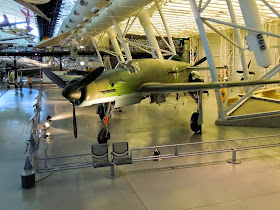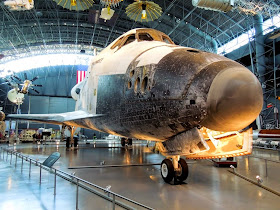Like its more Metro-accessible counterpart on the National Mall, many of the artifacts in this museum are not merely representative of type; they have specific stories to tell. As I explored, I did not see just an Aero Commander, a Cessna 180, a Boeing 707, and a B-29. Rather, I saw Bob Hoover's Aero Commander, Jerrie Mock's Spirit of Columbus, the protoype 707 / "Dash 80" rolled by Tex Johnson before a befuddled audience of Boeing and airline executives, and the Enola Gay. These are impressive aircraft with amazing stories behind them.
The cavernous space features airplanes hanging from the ceiling like Christmas tree baubles.
This gossamer contraption is the Langley Aerodrome. Samuel Langley, who was affiliated with the Smithsonian, was in competition with the Wright brothers to achieve powered, controllable, heavier than air flight (or, at least, he fancied himself a competitor). Langley never succeeded in urging his Aerdodrome aloft, though Glenn Curtiss succeeded in 1914 after making significant modifications to the design. When the Smithsonian leveraged Curtiss' work to promote the Aerodrome as the first heavier-than-air, manned, powered aircraft "capable of flight", the Wright brothers were outraged and retaliated by withholding the original 1903 Flyer from the Smithsonian. Instead, it was displayed in London until the Wright-Smithsonian feud ended in 1948.
Even among some of the wackier conveyances on display, I believe the Aerodrome to be the only "aircraft" in the collection that never actually flew (notwithstanding Curtiss' post hoc modifications, which were removed from the displayed Aerodrome). Though it is an interesting historical footnote, nepotism is the only reason I can see for Langley's flightless bird to be featured in the Smithsonian.
When I visit an aircraft museum, I often feel as though I am on safari. What airplanes am I going to discover there? An SR-71, the world's fastest, manned, air-breathing airplane, is a rare find indeed.
As emblazoned on the SR-71 tail fin, the Lockheed Skunk Works logo strikes me as needing an "ain't I a stinker?" caption.
A mere twenty-four years (first flights in 1940 and 1964, respectively) separate these two technological marvels. Astounding.
I can almost hear the growl! A Curtiss P-40 Kittyhawk.
A Naval Aircraft Factory N3N World War II trainer on floats! Unlike its wheeled cousins, I imagine this version presented little danger of ground looping.
The STOL Westland Lystander, a World War II era liason aircraft, with leading edge slats visibly deployed. One of these routinely flies at the Greatest Show on Turf in Geneseo, NY.
Kelly Johnson's fork-tailed devil, the Lockheed P-38 Lightning. This particular Lightning was once flown by Major Richard bong, America's top World War II fighter ace. Bong was conducting a test flight to assess a new flight control configuration when the right engine exploded in flight. Bong survived this accident, but perished in a P-80 Shooting Star in August 1945.
A beautiful Republic P-47 Thunderbolt, the heaviest single engine fighter of World War II.
A Vought F4U-1D Corsair with its distinctive inverted gull wing, one of the premier fighter aircraft of World War II.
A Northrup P-61 Black Widow, a purpose-built World War II night fighter.
Conquest I, a Grumman Bearcat modified for Air Racing with chopped wings, smaller canopy, and a massive propeller originally belonging to a Douglas Skyraider. Darryl Greenamyer broke a 30-year-old piston aircraft speed record in 1969 when he flew Conquest I at 483 miles per hour. Impressive airplane, but I do not care for the color scheme.
Another highly modified World War II fighter, Excalibur III, created from a North American P-51C Mustang.
A Grumman F6F Hellcat, a Naval fighter that boasted a 19:1 victory to loss ratio in the Pacific Theater. It was simple, rugged, and reportedly easy to fly.
And just look at that gap-toothed smile! Hellcat photobomb!
Curtiss SB2C-5 Helldiver, a World War II era dive bomber.
The Vought Kingfisher was a ship-based scout airplane.
The Enola Gay, of course, was the B-29 that dropped the first nuclear bomb at the close of World War II.
Display of the Enola Gay remains controversial. Regardless, there is no mistaking the historical significance of the airplane. It is presented "as is" with no value or judgement placed on its role in history. Its very presence inspires deep reflection.
If I understood the docent correctly, the black, block letters "ENOLA GAY" on the fuselage are the original ones painted there prior to the mission.
Focke-Wulf 190s were the only German World War II fighters with radial engines. After escaping from a German prisoner of war camp, Bob Hoover fled Germany in a stolen Fw 190. A captured Fw 190 is also attributed as Bob Hall's inspiration for the design of the Grumman Bearcat.
This odd looking Dornier Pfeil was a late World War II German twin-engine interceptor featuring tractor and pusher propellers.
The Messerschmitt ME-163 Komet, a rocket-propelled interceptor that was one of Germany's Wunderwaffen (wonder weapons).
This was not a back-up means of generating thrust for the ME-163.
The Komet's engine is quite small.
A Japanese Nakajima J1N1-S Gekko "Irving". This one is the sole surviving example of its kind.
This Aichi M6A1 Seiran was designed as a submarine-borne float-plane bomber. None were ever used in combat and this example is the only one to survive World War II.
A Grumman Intruder viewed from an unusual angle.
I still think that the MiG-21 is a cool looking airplane, even without the dramatic lighting (but it doesn't hurt).
A North American F-100 Super Sabre, the world's first fighter capable of level, supersonic flight. This example is a combat veteran and was in active service from 1957 to 1978.
A head on view of the Republic F-105 Thunderchief fighter-bomber, also known as the "Thud".
The first Lockheed Martin X-35B STOVL (Short Take Off, Vertical Landing) aircraft ever built.
The pitot mast on the X-35 has a number of additional sensors attached that appear to read pitch and yaw.
This is the Pratt and Whitney turbofan capable of vectoring thrust downward to support STOVL operations for the X-35.
I would hate to see the overhaul bill for this thing. It is a Lycoming XR-7755-3 thirty-six cylinder piston engine arranged in nine rows of four cylinders and rated for 5,000 horsepower at 2,600 rpm. Only two were ever built, none ever flew in anything but a test stand (turbine engines made them obsolete before development was finished), and this one is the sole survivor. Despite being hailed as the most powerful piston engine in the world, it sits in a museum as a curiosity and nothing more.
Pictured here is one of the main reasons the P-51 Mustang sounds so cool, the Merlin twelve cylinder 1,490 horsepower liquid cooled engine. This particular version was built in Detroit (woot!) by Packard under license from Rolls Royce.
This Hiller-conceived cross between a backpack and a helicoptor, the Rotorcycle, easily makes my "no way, no how" list.
A 1943 Kellett XO-60 Autogiro.
A Junkers tri-motor airliner, something of a low wing version of the Ford Tri-Motor.
The first airliner with a pressurized cabin, the Boeing 307 Stratoliner, first flew in 1938 and could carry passengers up to 20,000 feet with an 8,000 foot cabin pressure. At 20,000 feet, the airliner could overfly most adverse weather. The aircraft was designed using the wings, tail, and engines of a B-17 (and was likely a far more comfortable ride for passengers than its bomber predecessor).
No way, no how. The Stits SA-2A Sky Baby.
This Piper PA-12 Super Cruiser, City of Washington, is companion to City of the Angels. Together, they were the first two light aircraft to fly around the world. The City of the Angels is on display at the Piper Museum in Lock Haven, PA.
Seeing this airplane immediately brought a smile to my face. It is the Cessna 180, Spirit of Columbus, that Jerrie Mock flew around the world when she became the first woman to ever do so. For some reason, Jerrie never became a household name after her bold feat, but her story is worth knowing and I am pleased to see her airplane immortalized in the Smithsonian.
This beautiful Stearman biplane traces its roots back to training Tuskegee Airmen in World War II.
This is the first time I've ever seen a museum promote beer (or, in this case, a pale facsimile of beer). Bud Light sponsored Leo Loudenslager and the Laser 200 aerobatic monoplane he made famous.
The venerable Piper Cub takes its rightful place among the aeronautical giants at the Smithsonian.
It is virtually impossible to get the entire Concorde into frame, but I tried.
The "Airphibian", the first government-certified roadable aircraft (flying car). You guessed it, this goes into my "no way, no how" category. It looks to me like both a lousy car and a lousy airplane. But at least it flew, quite unlike the Langley Aerodrome.
When I was a kid, I read all that I could about space travel and watched the Space Shuttle go from concept to reality. Though I once saw the Challenger sitting on the launch pad in Florida, I had never seen a shuttle up close before.
The Discovery is on display at the Udvar-Hazy Center, having replaced the boilerplate prototype Enterprise that stood in this spot when I visited ten years ago.
As wondrous as it was to stand before the shuttle, I was a bit surprised at how crude a flying machine it appeared to be. With its slab-sided fuselage and stubby, non-cambered wings, the Shuttle is not nearly so elegant in form as most airplanes.
Outgassing from tiles along the side of the nose clearly indicated the direction of the relative wind upon atmospheric re-entry. The bottom of the ship bore the brunt of frictional heating.
Though perhaps not so elegant in form as its air-breathing cousins, the shuttle is nonetheless impressive in terms of what it accomplished.
I spent over four hours at the Udvar-Hazy Center. I cannot claim to have seen or read all there was to see and read, but I departed extremely impressed by the amazing swath of aeronautical history on display and the number of very human stories associated with so many of these flying machines.









































































Great photos. The Boeing 307 in that museum has an interesting history. After a 6 year restoration by Boeing employees, the test pilots put it into a lake after it ran out of fuel during a flight. It went back to Boeing and was RE-restored before being send to the museum.
ReplyDeleteThe "Bud Light" airplane is actually a very significant airplane in the history of aerobatics. Leo Loudenslager sort of ushered in the monoplane revolution with that Laser 200.
Thanks for commenting, Ron. I had not heard about the lake incident with the 307. Someone must have forgotten the "historic aircraft, avoid fuel exhaustion" placard for the instrument panel. How mortifying that must have been for everyone involved.
DeleteI confess that I may have been too flippant with my caption on the Laser 200.
Great pictures! This is on my bucket list, so much to see and soak in. Thanks for the sneak peek.
ReplyDeleteSounds like a great reason to visit Jeff F... :-)
DeleteI don't think I ever got around to posting all my photos from our visit last summer, whoops. And now you and go post ones so good that mine won't compare! Such important problems, obviously.
ReplyDeleteGlad you got to visit. We certainly think alike in that regard - my visit to the Aeroseum in Sweden was a similar impulse during a business trip.
I have visited many an aircraft museum while traveling for business. I was disappointed late last year when I included an extra day in my itinerary to visit Planes of Fame in Chino, but the airline delivered me to the area 24 hours later than they were supposed to, so I lost my free day.
Delete